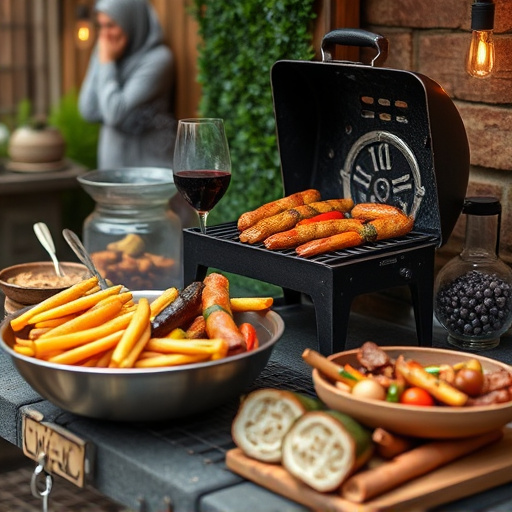Achieve a signature smoky flavor in your turkey BBQ recipe by slow-smoking at low temps with hickory or mesquite wood chips. Choose the right cut (breast, leg, whole legs, drumsticks, thin slices) for your desired cooking time and texture. Dry brine turkey pieces to enhance taste, preserve juiciness, and tenderize the meat. Create a balanced marinade with olive oil/apple cider vinegar, paprika, garlic powder, onion powder, brown sugar, salt, pepper, and cayenne. Grill at medium-high heat, sear, then move to indirect heat smoking at 350–400°F (175–200°C). Pair with complementary sides like salads, roasted veggies, mashed potatoes, and crispy toppings for a delicious turkey BBQ recipe.
Unleash your inner grill master with the ultimate guide to crafting a mouthwatering smoky turkey BBQ. This comprehensive article takes you on a journey from understanding the essence of a great turkey BBQ recipe to mastering grilling techniques. Learn how to choose the perfect cut, prepare a flavorful dry brine, and create a custom marinade for that distinct smoky flavor. Discover side dishes that complement your creation, along with expert tips for achieving BBQ perfection. Elevate your culinary skills with this essential guide to the ultimate turkey bbq recipe.
- Understanding Smoky Flavor: The Essence of a Great Turkey BBQ Recipe
- Choosing the Right Turkey Cut for Your Grill
- Dry Brining: Unlocking the Potential of Your Meat
- Crafting the Perfect Smoked Turkey Marinade
- Grilling Techniques to Achieve Perfection
- Pairing Side Dishes That Complement Smoky Turkey
- Tips and Tricks for a Delicious, Smoke-Infused Turkey BBQ
Understanding Smoky Flavor: The Essence of a Great Turkey BBQ Recipe
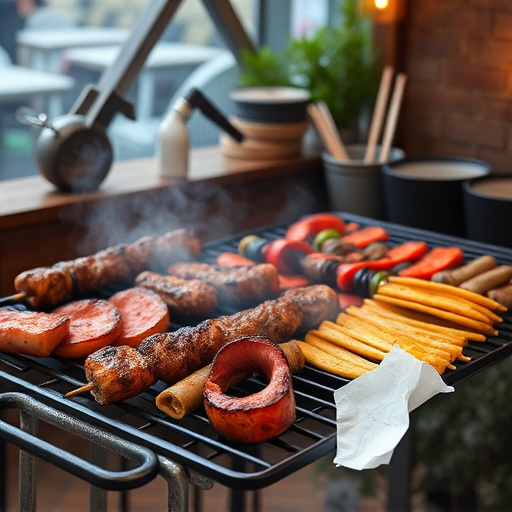
The smoky flavor is an integral part of what makes a turkey BBQ recipe truly exceptional. This distinctive taste, often described as savory and slightly sweet, is achieved through a combination of techniques. One of the most common methods is slow-smoking the turkey at low temperatures, allowing the smoke to penetrate the meat, infusing it with its characteristic aroma. The type of wood used also plays a crucial role; hickory, mesquite, or oak chips each impart a unique flavor profile that can transform your turkey from ordinary to extraordinary.
For a truly mouthwatering turkey BBQ recipe, balancing the smoky notes with the natural juices and tenderness of the meat is essential. This harmony is achieved through careful grilling or smoking, ensuring the heat gently cooks the turkey without drying it out. The result? A juicy, flavorful bird that tantalizes the taste buds and leaves your guests craving more.
Choosing the Right Turkey Cut for Your Grill

When it comes to grilling smoked turkey, selecting the right cut is key to achieving that perfect blend of tender meat and robust flavor. For a classic Turkey BBQ recipe, opt for breast or leg meat. The breast offers leaner protein, ideal for those watching their fat intake, while the leg provides a richer, more flavorful experience. Bone-in cuts, such as whole legs or thighs with the bone in, are excellent choices if you want to lock in moisture and enhance the smoky taste. These cuts take longer to cook but result in incredibly juicy and flavorful grilled turkey pieces.
For a faster option, consider cutting your turkey into drumsticks, drummettes, or even thin slices for skewers. These smaller pieces allow for quicker grilling times, making them perfect for when you’re short on time but still want that delicious smoky flavor. Remember, the cut you choose should align with your preferred cooking method and desired doneness to ensure the best-grilled turkey experience in your BBQ recipe.
Dry Brining: Unlocking the Potential of Your Meat
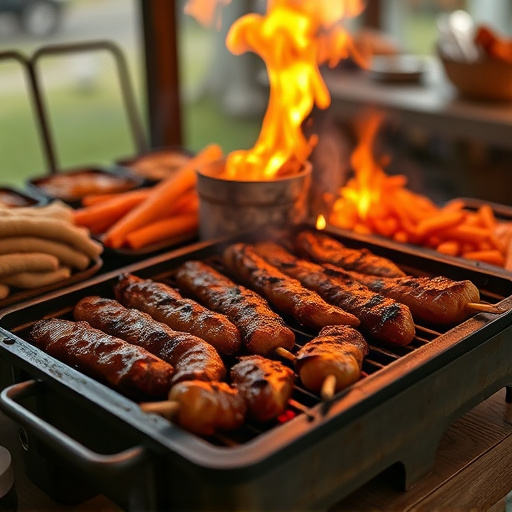
Dry brining is a time-honored technique that significantly enhances the flavor and texture of grilled turkey pieces, making it an indispensable step for any serious turkey bbq recipe enthusiast. By curing the meat with salt and various spices, this method draws out moisture, allowing the seasonings to penetrate deeply into the flesh. This process not only adds complexity to the smoky flavor but also tenderizes the turkey, ensuring each bite is juicy and succulent.
The benefits of dry brining are threefold. First, it improves the overall taste profile by intensifying natural flavors. Second, it helps preserve the meat’s juiciness during the grilling process, preventing dryness. Lastly, it can transform ordinary turkey into a standout feature at any barbecue gathering, satisfying both seasoned chefs and casual enthusiasts alike.
Crafting the Perfect Smoked Turkey Marinade
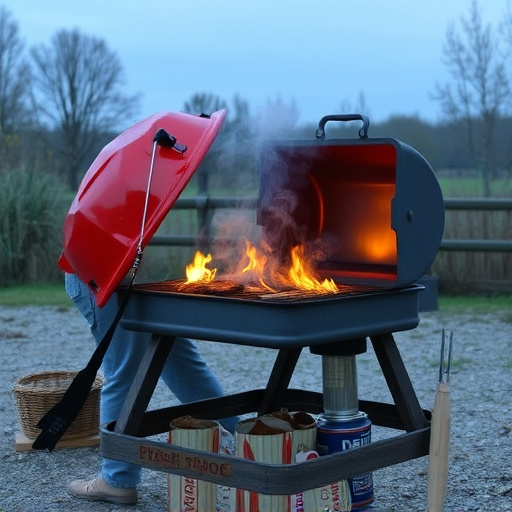
Crafting the perfect smoked turkey marinade is an art that combines the right balance of flavors to infuse into your grilled turkey pieces. Start with a base of high-quality olive oil or apple cider vinegar, which will help penetrate the meat and add moisture. Next, incorporate aromatic herbs like paprika, garlic powder, and onion powder for a smoky, savory taste. A touch of brown sugar adds sweetness that balances out the smoke, while salt and pepper enhance all other flavors. For an extra kick, include spices such as cayenne or chili powder, depending on your preference for heat.
Mix these ingredients thoroughly, ensuring each element is well-blended before marinating your turkey. Consider letting the meat soak for a few hours or even overnight in the refrigerator to allow the flavors to meld and penetrate deeply into the tissue. This step is crucial for achieving tender, flavorful grilled turkey pieces that showcase the essence of a perfect turkey BBQ recipe.
Grilling Techniques to Achieve Perfection
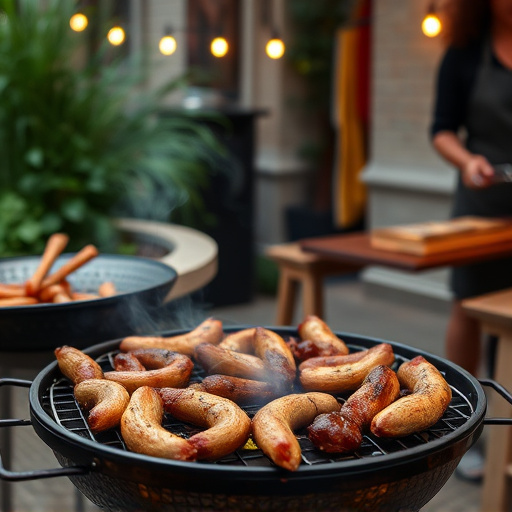
To achieve perfect grilled turkey pieces with a smoky flavor for your turkey BBQ recipe, mastering the grilling technique is key. Start by preheating your grill to medium-high heat, ensuring even and consistent cooking. Oil the grates lightly to prevent sticking, and consider using a grill brush to create a non-stick surface. Place the turkey pieces on the grill, allowing them to sear for a few minutes before turning. This step helps to form a crispy crust and seals in juices.
The key to smoky flavor lies in indirect heat and the use of wood chips or chunks. After direct searing, move the turkey to a cooler section of the grill and add your chosen smoking wood. Maintain a steady temperature around 350–400°F (175–200°C), allowing the smoke to gently infuse the turkey with its distinctive flavor. Regularly baste with a dry rub or marinade to enhance both moisture levels and taste, ensuring your turkey BBQ recipe turns out juicy and delicious.
Pairing Side Dishes That Complement Smoky Turkey
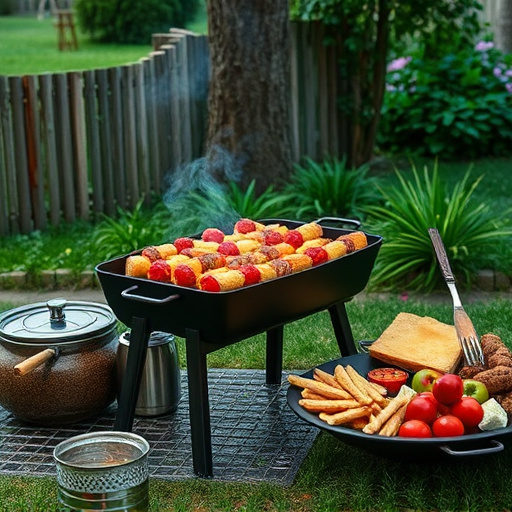
When it comes to a turkey BBQ recipe, the side dishes play as crucial a role in enhancing the smoky flavor as the grill itself. Pairing sides that complement the smoky turkey can elevate your dining experience significantly. Consider crisp salads with a tangy vinaigrette or roasted vegetables infused with herbs—both options provide a refreshing contrast to the rich, smoky taste of the grilled turkey pieces. Mashed potatoes enriched with garlic and butter are another excellent choice, offering a comforting and creamy balance to the robust flavor profile. For a touch of crunch, try incorporating crispy bacon bits or toasty bread crumbs into your sides, adding depth and texture that harmonize perfectly with the turkey’s smoky notes.
Tips and Tricks for a Delicious, Smoke-Infused Turkey BBQ
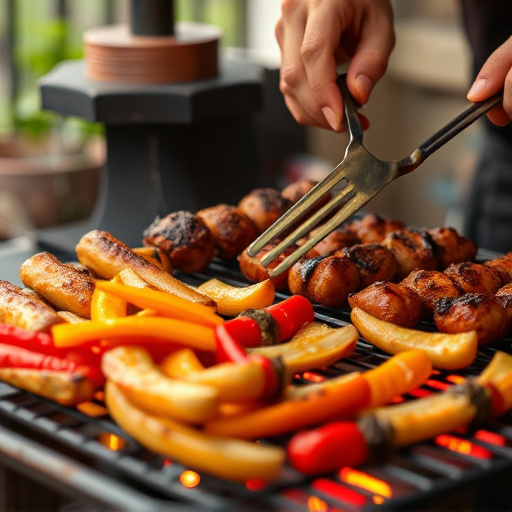
To craft a delicious smoke-infused turkey BBQ, start by marinating your turkey pieces in a blend of your favorite spices and liquid smoke for at least 30 minutes before grilling. This step is key to infusing that distinct smoky flavor throughout the meat. Use a dry rub consisting of paprika, garlic powder, salt, pepper, and a touch of brown sugar for an extra layer of complexity; apply this generously before cooking.
When it comes to grilling, low and slow is the name of the game. Set your grill to medium-low heat and allow the smoke to build up. Place the turkey on the grill, ensuring even heat distribution. Maintain a consistent temperature throughout the cooking process, adding wood chips or chunks as needed to sustain the smoke. For best results, aim for an internal temperature of 165°F (74°C).
